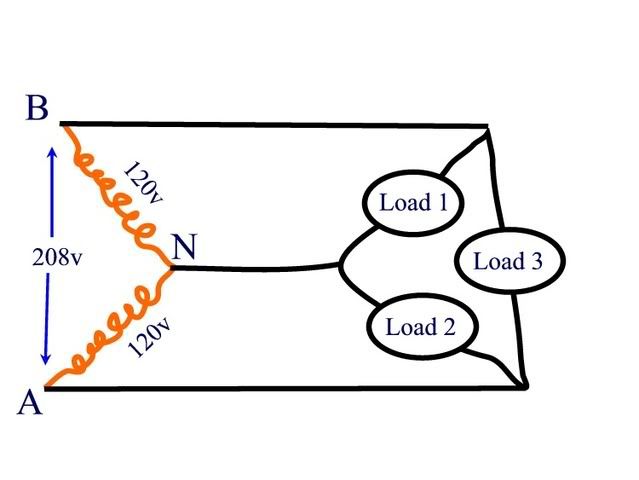ultramegabob
Senior Member
- Location
- Indiana
I have never ran across 120/208 3 wire system as a single phase... if I did run across it, I would probley be calling the power company wondering what was up....
crossman said:With only two ungrounded conductors and the neutral of a 208Y/120 3phase 4wire system, we can take two single phase transformers and create three phase.
The IEEE may call this single phase (and I don't neccesarily disagree with them). But, with single phase 240/120 3 wire, the neutral only carries the unbalanced load and doesn't have to be counted as a current-carrying conductor. This is not true of the 208/120 system with 2 ungrounded conductors and a grounded conductor. The grounded conductor has to be counted as a current carrying conductor because the loads do not balance.
I've always called it a "network". and I just thought I was being clever. :grin:mivey said:Winnie, why don't we just use the terminology that EEI uses for metering and call a 120/240 a single phase service and a 120/208 a network service?
[edit: Marc, you just did beat me to the finish line]
mivey said:frenchelectrican,
I believe hardworkingstiff has left us hanging bro. We have been disenfranchised. :grin:
hardworkingstiff said:There has been a lot of intense discussion about 208/120-volt "single-phase" service. What do you think?
LarryFine said:After all, what do we call it when a 3-phase motor loses a phase?
crossman said:...208 L1-12 and L1-N and L2-N can create three distinct and seperate out of phase currents. And three distinct and seperate currents, all out of phase with each other looks like 3 phase to me...
You were just ahead of your time. Mort de Rire (for you Marc)Karl H said:I've always called it a "network". and I just thought I was being clever. :grin:
The "bowstring" neutraltryinghard said:Where is the 3rd phase?
mivey said:The "bowstring" neutral
Lots of it in my area. They call this a "network service". They run all three phases around at distribution voltages, and just jump off here and there with single phase to each building (or 3-phase, if you need it). Lets them put one large transformer somewhere out of the way. These network services (often called network loops) are typically double end fed, to allow sectionalizing a part for service without taking an outage for everyone on the network.ultramegabob said:I have never ran across 120/208 3 wire system as a single phase... if I did run across it, I would probley be calling the power company wondering what was up....
tryinghard said:Where is the 3rd phase?

It is a neutral point that is not on a vector line drawn beween the two conductors V1 & V2. Since this reference point is shifted away from the V1-V2 vector, the path drawn from V1 to N to V2 is no longer straight (like in a 120/240) but has a "bow" in it (see crossman's picture). This offset neutral reference gives us the angle we need to create rotation.tryinghard said:I'm not sure what "bowstring neutral" is but in this case the neutral would not be a supply phase like one of a three-phase system, rather it is a return [phase] grounded conductor??
I guess sloppy wording caught up with me again. We should use the term "3-wire network service" when referring to the 3-wire 120/208 service. I think this is different from the network you were referencing.mdshunk said:...They call this a "network service"...
mivey said:frenchelectrican,
I believe hardworkingstiff has left us hanging bro. We have been disenfranchised. :grin:
quogueelectric said:No way no how can anyone convince me that 2 xformer windings 120* electrically out of phase can be considdered single phase. It is not so get over it.
Could you please describe these two calculations and/or what you see to be the difference in these two calculations?e57 said:Which calculation method would you use - single phase, or 3 phase serving single phased loads?

